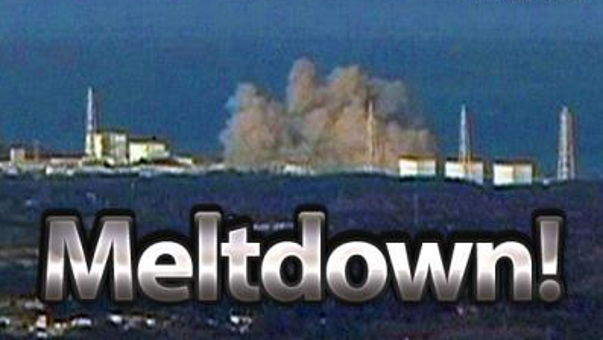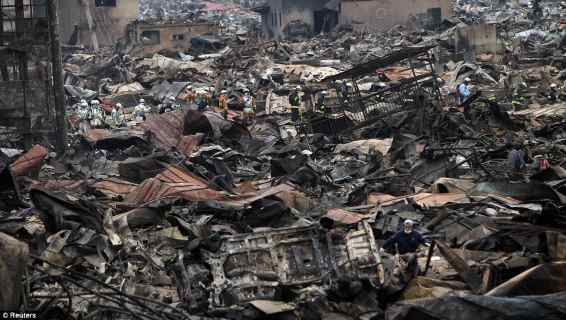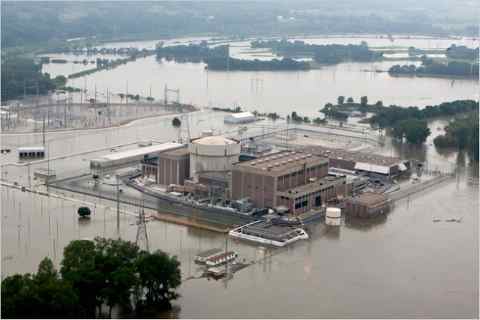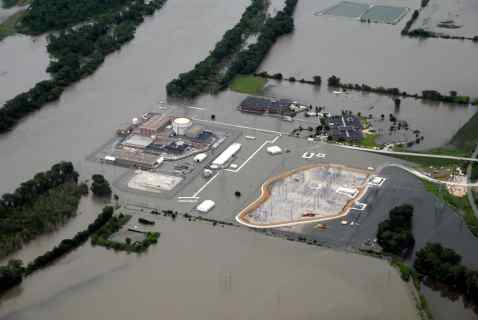“Fukushima: Dispossession or Denuclearization?”
“Fukushima: Dispossession or Denuclearization?” is a definitive and riveting book on the Fukushima nuclear catastrophe which has recently been published . If there is one sober assessment of what this unparalleled event means to humanity, this scholarly yet practical review is it.
The last chapter of this extraordinary and eye-opening exposé provides only a glimpse into what are perhaps the most important messages that Fukushima has to deliver to humankind.
This exceptional treatment of the Fukushima disaster offers both uniquely penetrating insights and weighty conclusions. These inescapable conclusions must now be acknowledged, and responded to with great immediacy, by Japan and the world community of nations.
THE NUCLEAR ENERGY PARADIGM COLLIDES WITH EARTH CHANGES AND TECHNOSPHERIC BREAKDOWN
The Fukushima Five
The title of this chapter does not really represent its most important message. Undoubtedly, Earth changes are upon us in the form of increased seismic activity and volcanism. Global Climate Change is intensifying on every continent. And technospheric breakdown is accelerating by the year.
However, that the worldwide Nuclear Energy Industry (NEI), and the governments which regulate it, proceed down the same road despite these changing realities points to one thing in particular. As follows:
The voice of reason has fled humankind, especially within the scientific establishment which informs the Nuclear Energy Paradigm (NEP).
Likewise, common sense has become quite rare throughout the governments and corporations of the world where nuclear power generation has been promoted.
Because of this unfortunate state of affairs, critical decisions about the outworking of the Nuclear Energy Paradigm have been made, which have put whole populations around the world in great danger. In the same way, nations such as Japan have risked their future for the sake of clinging to an energy source which no longer makes any sense, nor ever did.
Why would the people of Japan put their four major islands in such jeopardy? “What jeopardy?” the Japanese politicians and officials at TEPCO ask.
Aid workers make their way through debris and destruction after the March 11th tsunami struck Japan’s northeast coastline.
Just prior to the M9.0 earthquake and subsequent tsunami on March 11, 2011, Japan had 55 nuclear reactors in operation throughout the country, with an additional 12 approved and in various stages of development. Despite the fact that Japan is located in one of the most seismically active regions in the entire world, TEPCO and the Japanese government have relentlessly proceeded in the direction of nuclear power generation to meet the nation’s energy needs.
Our journey into the minds of those critical decision-makers begins here. Particularly in light of the fact that Japan was already the site of two nuclear disasters during World War II, one would think that the national and corporate leadership had been forewarned. And yet they proceeded to site virtually every nuclear power plant on the coastlines of the four main islands, exposed to all sorts of earthquakes and tsunamis.
First let’s establish that there is a huge difference between the risks and dangers associated with nuclear energy and those that simply don’t exist with hydrocarbon, hydroelectric, coal, solar and wind power generation models. When those power plants get hit by an earthquake, or overwhelmed by a tsunami, they simply shut down. There may be serious localized damage, but it’s usually very easy to contain and straightforward to fix.
Most importantly, such inevitable Earth change events will not precipitate a global catastrophe, as was the case with the Fukushima Nuclear Disaster. Whether by way of typhoon or tornado, earthquake or volcano, tsunami or flood Japan’s nuclear power plants, especially in view of their locations, will always remain extremely vulnerable. Hence, it can be stated with complete certainty that the responsible decision-makers committed a huge blunder by taking Japan in the direction of nuclear energy in the first place.
How has Common Sense Become Rare and the Voice of Reason Muted?
This entire chapter could easily end right here … end of discussion for any rational person who simply applies human reason to the predicament of Japan. How so? When a good answer cannot be provided to the following questions, what else is there to discuss about the viability of nuclear power generation on the most earthquake-prone island nation in the world?
1) What was the contingency plan at Fukushima, and for all the other nuke plants throughout Japan, should a tsunami overwhelm the plant buildings and completely cut off the electricity supply? When a long term disruption occurs, how will the reactors be cooled down?
2) How is a nuclear meltdown to be prevented in the wake of radioactive explosions and exceedingly high levels of radiation measured throughout the entire local area? How is the safety guaranteed of all the emergency personnel tasked with making the repairs necessary to prevent a meltdown or worse?
3) What was the TEPCO contingency plan in Fukushima should the power supply be cut off from the cooling pools where the spent fuel rods were being stored? What are the standard operating procedures in place throughout the rest of the nation’s nuke power plants?
If there is not a reasonable and actionable implementation plan for any of these predicaments, should they occur, then the plants simply shouldn’t be there. And, yet, there they sit — without any discussion of these and many other catastrophic contingencies — while the politicians in Tokyo talk about the coming Summer Olympics in 2020. It’s important to bear in mind that Tokyo is a mere 180 miles from Fukushima, and that some of the Olympics venues are even closer!
When the Faculty of Human Reason Fled Humankind
Not only does no one really know the extent of the environmental damage left in the wake of the Fukushima nuclear disaster, no one knows how it might further develop in the future. Nevertheless, the government persisted in their pursuit of the Olympics to be played out right in the backyard of perhaps the greatest nuclear catastrophe in history. The decision process in both cases cannot be driven by simple logic or rationality.
If ever there was an event which exposed a clandestine plot going on behind the scenes for several decades, Fukushima is it. Certainly those who have directed Japan’s destiny failed to take into consideration the obvious: That Japan occupies the most earthquake-ridden piece of real estate on the planet, and that Global Climate Change does not discriminate; it can show up on anyone’s doorstep uninvited and when least expected.
What the whole world has witnessed since that fateful day in 2011 is one earthquake after another, together with a number of severe storms buttressing the four main islands. In each instance, all of Japan’s neighbors — friends and foes alike — watch with baited breath for the many and various outcomes. Particularly in light of how precarious the situation at Fukushima continues to be, is the entire community of nations wondering if and when this intractable situation will be resolved? Clearly, we shouldn’t even be here, and wouldn’t be if those responsible had applied even a modicum of common sense during the incipient stages of development of Japan’s nuclear energy policy.
Fukushima Feels the Brunt of the Perfect Storm
Fukushima is a perfect example of exactly what can go wrong, particularly when the Perfect Storm blows throughout the area. Just as Superstorm Sandy revealed just how old and antiquated much of the infrastructure is throughout Lower Manhattan, the March 11th earthquake and tsunami of 2011 allowed the many manmade problems and inherent weaknesses of the Fukushima Daiichi Power Station to surface over the course of the following weeks. Each day of the unfolding nuclear disaster seemed to bring a new development, none of them being positive. Some of these were expected; some came out of left field.
At the end of the day it was obvious that no power plant could withstand an M9.0 earthquake and 45-foot high tsunami (See Graphic [2]). However, even much lesser events could take greater tolls on such a vulnerable location as Fukushima … or Tokai (Tokai Village)… or Onagawa, the sites of other nuclear power plants. The moral of this story, and it is worth repeating until Japan — the whole nation — gets the message, is that they had NO business building these nuclear power plants along one of the most seismically active coastlines on the planet.
An article titled “Magnitude 6.8 earthquake off Japan coast triggers tsunami” (Associated Press) appeared in the media as this chapter was being written. Truly another telling sign that this whole predicament can be quickly duplicated anywhere along the Japanese coastline where nuclear power plants are located.
In addition to the constant threat of earthquakes and tsunamis, there is also the growing number of typhoons (Kageyama, Y.) making landfall on the Japanese coast. The increasing intensity of these storms is putting them in the same category as Superstorm Sandy. Therefore, they will undoubtedly serve to reveal more problems with the nuclear plants that dot the Japanese coastline should they receive direct hits in the future.
Global Climate Change Reveals Fatal Flaws of the Nuclear Energy Paradigm
While Fukushima is the poster child for everything that can go wrong — very wrong — with nuclear power generation, there have been several instances since March of 2011 which have highlighted the inherent weaknesses found in the global Nuclear Energy Paradigm.
Photos often tell the story much better than all the words in the world. The media carried startling photographs of Nebraska’s Fort Calhoun Nuclear Power Station during the floods of June, 2011. (See Graphics [3 and 4]) The plant was completely surrounded by floodwaters and under threat of losing its power supply. Even though it had been in cold shutdown since April, it was still vulnerable to problems not too dissimilar to the Fukushima Daiichi plant.
Graphic #3 – Fort Calhoun Nuclear Power Station
As most of us know, the mainstream media rarely reflect the true gravity of either natural or manmade disasters. As an example, for days immediately following the M9.0 earthquake the media repeatedly reported a death toll of between 100 and 200 people after the tsunami struck the northeast coastline of Honshu Island on March 11, 2011. Certainly the authorities knew very quickly the devastation that the 45-foot high tsunami had inflicted. That whole towns and coastal villages were swept away became common knowledge after the first flybys. So was the fact that tens of thousands of Japanese citizens had been killed by this tragic event. Some of the most authoritative accounts have reported that upwards of 30,000 people passed away from the tsunami and aftereffects which lingered for months due to an exceptionally unresponsive government in Tokyo.
What’s the point? The governments (and the press) are both conditioned to grossly understate the seriousness of any matter which impacts so many citizens in any given area. Therefore, when the big media outlets do trumpet a genuine concern about the integrity of the nuclear power generation model, as they did in the wake of the Nebraska flooding, it can be safely assumed that some critical issues have not been thought out. Hence, we saw headlines like the following:
Flooding Brings Worry About Nebraska Nuclear Plants (Sulzberger and Wald)
Fort Calhoun Nuclear Plant: Flood Seeps Into Turbine Building At Nebraska Nuke Station (Funk and Lampe)
Flooded Nebraska nuclear plant floods, raises broader disaster fears (Hargreaves, S.)
The US Is Having A Catastrophic Nuclear Emergency In Nebraska And The Obama Administration Is Covering It Up (Blodget, H.)
Fort Calhoun Nuke Plant Flood Wall Collapse the Result of Accidental Puncture (The Doc)
Graphic #4 – Fort Calhoun Nuclear Power Station
There is one central and critical point which the preceding photographs graphically portray. Because of the ongoing intensification of Global Climate Change, this scenario can repeat itself virtually anywhere around the globe. Wherever there is a nuclear power plant, it can be overwhelmed by floodwaters if the rains and subsequent flooding are severe enough. When the plants are located on the coastline, as many are, to provide easy, inexpensive access to ample water supply, the threats greatly increase due to hurricanes and typhoons.
The real question remains, therefore, as to what type of contingency plans the various nations of the world have in place to address the worst case scenarios. The Perfect Storm that occurred at Fukushima can easily be duplicated in the form of a catastrophic weather event that temporally paralyzes a nuclear power plant, especially one that is in the way of raging floodwaters or a category 5 hurricane or typhoon.
It’s almost as though Mother Nature endangered two, not just one nuclear power plant, in 2011 as a way of showing the whole world that every plant is just a superstorm, earthquake, flood, or tsunami away from a full-blown nuclear disaster. In view of the government and corporate response during the Fort Calhoun flood, it’s clear that circumstances can, and do, arise which present extremely challenging predicaments. Sometimes they can be waited out; sometimes they can’t, as we have all seen with Fukushima.
To continue reading this chapter, click HERE.
“Nuclear Energy Paradigm Fatally Flawed from the Start”[1]
This chapter delineates some of the most consequential repercussions associated with the continuation of the Nuclear Energy Paradigm. In fact this exposition portrays inevitable outcomes that are so weighty and far-reaching that its final conclusions cannot be denied, refuted or challenged in any way.
Truly, the entire planetary civilization has been given an unparalleled wakeup call from the greatest nuclear catastrophe in modern history universally known as F U K U S H I M A.
Other useful resources:
Backyard Innovator (A Self Sustaining Source Of Fresh Meat,Vegetables And Clean Drinking Water)
Blackout USA (EMP survival and preparedness)
Conquering the coming collapse (Financial advice and preparedness )
Liberty Generator (Build and make your own energy source)
Backyard Liberty (Easy and cheap DIY Aquaponic system to grow your organic and living food bank)
Bullet Proof Home (A Prepper’s Guide in Safeguarding a Home )
Family Self Defense (Best Self Defense Strategies For You And Your Family)
Sold Out After Crisis (Best 37 Items To Hoard For A Long Term Crisis)
Michael Thomas
StateoftheNation2012.com
Editor’s Note:
Michael Thomas is a member of The Fukushima Five and therefore one of the authors of the chapter posted above entitled:
The Nuclear Energy Paradigm Collides with Earth Changes and Technospheric Breakdown.
SOURCE : www.storyleak.com






